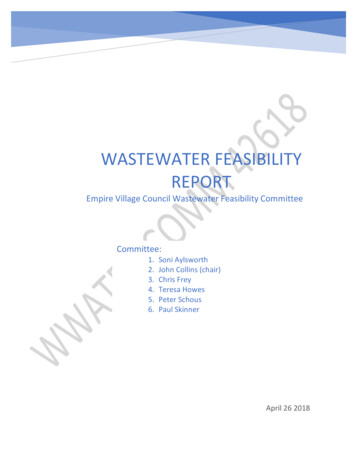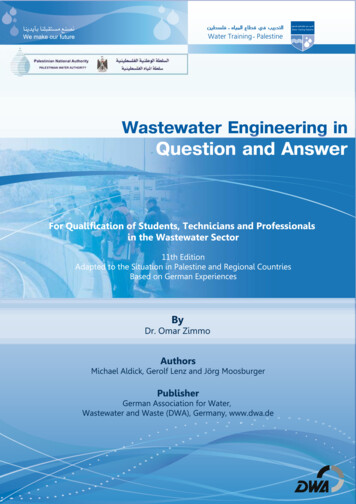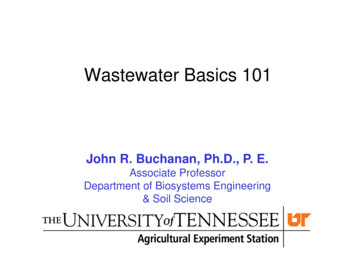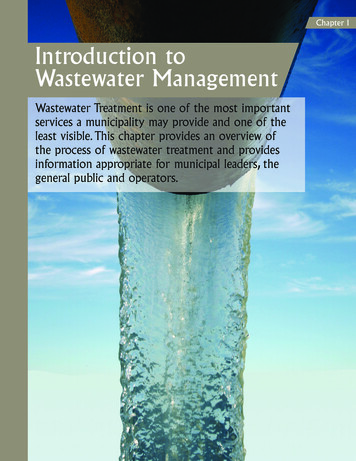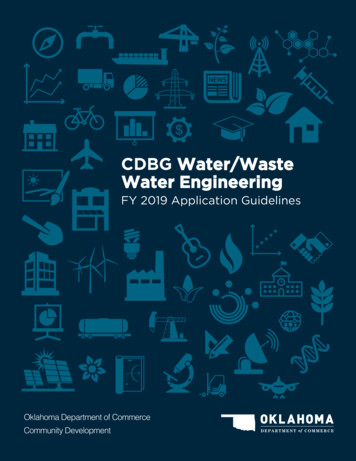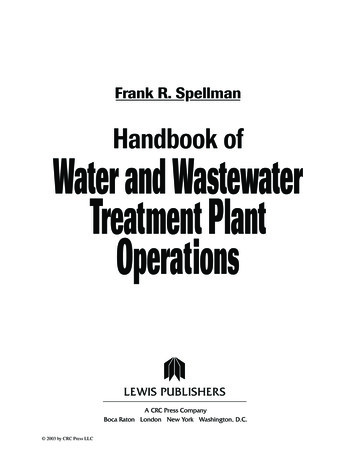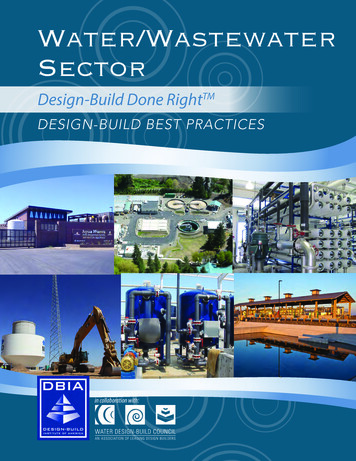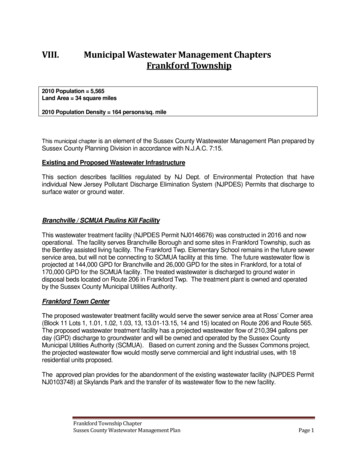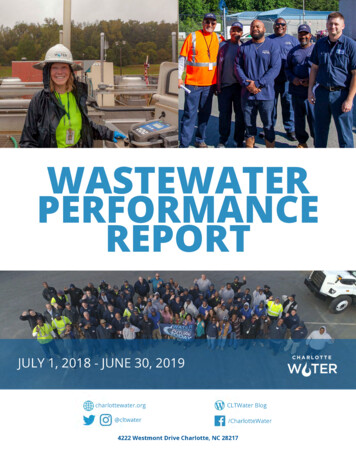
Transcription
ter4222WestmontDriveCharlotte,NC28217
I. General InformationName of Regulated Entity and Responsible PersonCity of CharlotteDavid Czerr, Interim DirectorCharlotte Water (CLTWater)Administration Division4222 Westmont DriveCharlotte, NC 28217704-336-4407Applicable PermitsThere are seven wastewater treatment plants (WWTP) owned and operated byCharlotte Water (CLTWater). Below is a list of these facilities and their applicableNPDES (National Pollutant Discharge Elimination System) permit number. Includedwith the list of facilities is the name of the Operator in Responsible Charge (ORC) atthe facilities and the site telephone numbers.WWTPIrwin Creek WWTPMallard Creek WRFMcAlpine Creek WWMFMcDowell Creek WWTPSugar Creek WWTPAshe Plantation WWTPOxford Glen WWTPNPDES 0024937NC0065749NC0063584ORCMichael LingerfeltHenry EudySandy Kim NeelyDarrell DeWittWilliam AllenJeremy NanceJeremy 875-6443704-432-2510704-634-3389704-634-3389In addition to those seven plants, CLTWater sends wastewater to the Rocky RiverRegional Wastewater Treatment Plant through an agreement with The Water andSewer Authority of Cabarrus County (WSACC). CLTWater also accepts flow fromUnion County to McAlpine Creek WWMF.WW COLLECTION4100 W. Tyvola Rd.Wastewater Performance ReportNCDWQ Permit NumberWQCS00001ORCSteven WrobleskiAugust 2019Phone704-432-27481
Description of collection and treatment systemsCharlotte Water (CLTWater) collects wastewater from approximately 264,981households and businesses throughout the county. Wastewater is collected anddirected (via gravity flow supported by sewage lift stations) to one of sevenCLTWater wastewater treatment plants or the Rocky River Regional Plant (ownedand operated by the Water and Sewer Authority of Cabarrus County) where it istreated. An average of 91 million gallons of wastewater is treated and dischargedeach day from CLTWater plants. CLTWater contributes an average of 4.58 milliongallons a day (MGD) to the Rocky River Plant. CLTWater also treats roughly 2.45MGD from Union County at CLTWater’s McAlpine Creek Plant or roughly 4.6% of the52.5 MGD treated at that plant.More than 300 of CLTWater’s 997 employees work to maintain 4,375.98 miles ofcollection pipelines and 82 wastewater lift stations throughout the county. Thegravity wastewater pipes in this system range in size from 8 inches in diameter to78 inches in diameter.Each of CLTWater’s wastewater treatment plants applies primary, secondary andadvanced treatment to the waste stream. Large solid particles and inorganicmaterials are removed by screening and settling. The wastewater is treatedbiologically to remove dissolved pollutants. Disinfection reduces bacterial andpathogenic materials. Finally, the waste stream passes through granular filters toremove very small particles that may not have been removed through the settlingprocess. The treated water is released to the nearby creek.Wastewater Performance ReportAugust 20192
1.Primary TreatmentSolid particles & objects are captured by screens, grit chambers, and primaryclarifiers.2.Aeration/Secondary TreatmentWastewater is aerated to support growth of microorganisms that removeharmful pollutants.3.ClarificationSolids and microorganisms settle out in large basins.4.Advanced TreatmentWastewater flows through granular filters to remove fine particles. Nutrientlevels are reduced at McDowell and McAlpine Creek Wastewater TreatmentPlants.5.DisinfectionWater is disinfected to remove any remaining pathogens, and then the treatedwater is released into creeks.Wastewater Performance ReportAugust 20193
II. Summary of System PerformanceFY19 PerformanceCharlotte Water successfully collected and treated 99.9 percent of the more than 33billion gallons of wastewater the community produced in the past fiscal year. Therewere 162 sanitary sewer overflows (SSOs) in our community, a decrease of twospills compared to the year before.Yearly SSOs vs 5-Year Moving 2241501771891641001629050Yearly SSOsFiscal Year5-Year Moving AverageReportable SSOsThe number of spills per 100 miles of pipe continued to decline from 10.8 in 2007to 3.7 spills in fiscal year 2019 as illustrated by the table on page 5.Wastewater Performance ReportAugust 20194
SSOs/100 MilesNumber of SSOs/100 Miles vs 5-Year Moving 34.24.43.73.82.1Fiscal YearSSOs/100 Miles5-Year Moving AverageReportable SSOS/100 MilesInspection crews and our customers find overflows. Overflows from the wastewatercollection system are discovered during routine inspections of the system and alsothrough reports from the public to 311. CLTWater notifies media any time asanitary sewer overflow results in 1,000 gallons or more reaching surface waters orany size overflow reaching recreational waters. A legal notice is posted in theCharlotte Observer when overflows of 15,000 gallons or more reach surface waters.Crews also use door hangers to notify customers when appropriate, which is apermit requirement.This annual report includes all incidents where wastewater escaped out of a publicmanhole or public collection system pipe before reaching proper treatment,including spills less than required reporting thresholds (i.e. less than 1,000 gallonsor any amount reaching surface water). There were 90 reportable spills (by statedefinition) during fiscal year 2019, 17 less than the fiscal year 2018 total of 107. Allspill response protocols are followed regardless of the spill volume or reportingstatus. Private spills and sewer backups inside homes are not included. The reportsummarizes spills (both reportable to the State and those escaping the sewer) andother challenges at wastewater treatment plants.Wastewater Performance ReportAugust 20195
CLTWater employees work 24 hours a day, 365 days per year, to prevent andrespond to overflows. Crews prevent overflows by clearing pipes of tree roots andgrease, as well as replacing broken and aging pipes. CLTWater has increased itsefforts to educate customers about properly disposing of fats, oils and grease(FOG).Performance Highlights CLTWater celebrated some important milestones in FY2019 even as it tooknumerous actions to prevent overflows and protect water quality througheffective wastewater treatment.Our wastewater treatment plants met 99.97 percent of all permitted dischargelimits.All seven wastewater treatment plants earned Peak Performance Awards fromthe National Association of Clean Water Agencies (NACWA) for the calendar yearending 2018. NACWA Peak Performance Awards recognize wastewatertreatment professionals throughout the nation for protecting the environmentand public health through outstanding treatment and discharge regulatorycompliance. McAlpine Creek Wastewater Treatment Plant was awarded itsseventh Platinum Award for eleven consecutive years of perfect compliance.McDowell Creek Wastewater Treatment Plant earned their second PlatinumAward, and their sixth out of last eleven years. Oxford Glen, Mallard Creek, andSugar Creek Wastewater Treatment Plants earned Gold Awards for zero permitviolations in a one-year period. Ashe Plantation and Irwin WastewaterTreatment Plants earned a silver with each having only one permit violation in aone-year period. Over 6,200 compliance tests were conducted during the 2018calendar year.21.5 miles of wastewater pipe and 301 manholes were rehabilitated or replaced.259 miles of wastewater pipe were treated with root control chemicals.921.83 miles of wastewater lines were cleaned (including some multiplecleanings in the same location) by CLTWater Field Operations Staff and anadditional 49.52 miles of pipe were cleaned by contractors.248 wastewater service connections were replaced.23 miles of rights of way were cleared by contractors to maintain access to offstreet sanitary wastewater pipes and to help prevent root intrusions. Anadditional 60.25 miles were cleared by CLTWater staff.172 miles of pipe were closed circuit television recorded (CCTV) for inspection byCLTWater staff and contractors.Wastewater Performance ReportAugust 20196
There are 82 Wastewater Lift Stations serving the CLTWater service area. Staffperformed 161 preventative maintenance/electrical tasks for a total of 3,180work hours. This does not include daily/weekly station checks, wet well cleaning,emergency generator testing, or emergency/routine repairs. Mint Hill CommonsLift Station was added and a new Steele Creek Lift Station began service.McAlpine Creek Wastewater Treatment Plant captures and converts methanegas (a byproduct of wastewater treatment) into a fuel for electricity productionand useful heat. In the past 12 months the engine has had an average uptime of70%. The generator has created more than 15 billion kilowatt hours, resulting ina power credit of close to 600,000 total. Running at 1 megawatt (MW), theengine puts out the equivalent of about 5 acres of solar, around the clock andeven on cloudy days. Methane gas is also generated at Irwin, McDowell, andMallard WWTPs. Methane gas is used to generate heat required for anaerobicdigestion to treat the solids produced during the treatment process.Capital & Community Investment HighlightsAyrsley Gravity Sewer Replacement Phase 2 started construction in August2017 and is complete. This is a 2.5 million investment to serve the growingpopulation in the South Tryon I-485 area. Beards Creek Wastewater Improvement Project started construction inSeptember 2018 and will be complete by end of summer 2019. Crews areupsizing 4,100 linear feet (LF) of pipe to serve growing area in easternMecklenburg County This is an investment of 4 million. Belmont and Optimist Park Wastewater Pipe Replacement (Little Sugar CreekTributary Trunk Sewer North Tryon area) began in October 2018 and will becomplete by April 2021. Approximately 6,327 LF of pipe is being upsized toserve the growing area around Belmont and Optimist Park neighborhoods.The project is an investment of 12.3 million. Briar Creek Relief Sewer Project (Phase Three) began in 2016 and is completewith substantial completion as of February 10, 2019. Coffey and Taggart Creek Outfall project provides for the evaluation, design,and construction of necessary improvements to the Taggart Creek Outfall tohelp manage flows and support growth from Taggart, Long, and Paw basins. Doby Creek Sanitary Sewer Pipeline Improvements serves areas beingdeveloped along the Blue Line Light Rail Extension. The pipeline projectreplaces 15,600 LF of gravity sewer to meet projected demands of the subbasin. The project is 76% complete. Wastewater Performance ReportAugust 20197
Four Mile Creek Tributary Wastewater Project is upsizing 4,300 LF of pipe toserve growing area in Town of Matthews. The project started in April 2019and should be complete in first quarter of 2020. This is an investment of 2.6million.Irvins Creek Tributary Wastewater Improvement Project is installing 3,850 LFof pipe to serve Town of Mint Hill neighborhoods. The project started inJanuary 2018 and be complete by end of 2019. This is an investment of 3.9million.Irwin Creek Tributary Wastewater Pipe Replacement Project (Fieldcrest Roadto Barringer Drive) installed 3,988 LF of larger pipe to serve South Charlottearea. This is an investment of 2.5 million.Irwin Creek Wastewater Treatment Plant Improvements Phase II providesrenovations and equipment upgrades to the grit facility, primary andsecondary clarifiers, aeration basins, chemical feed facility, blower building,filters, power distribution system, yard piping and instrumentation andcontrols.Little Sugar Creek Tributary to Fairview Road Sanitary Sewer Improvementsproject provides for 6,400 LF of 30 & 24 inch sanitary sewer lines that parallelFairview Road to the south from Park Road Park to Sharon Road. The projectwas substantially completed in April 15, 2019.Mallard Creek Wastewater Treatment Plant Rehabilitation and UV Upgradeconsists of the rehabilitation and upgrade of the Final Clarifiers and theirpumping stations, Effluent Filters, and UV Disinfection System. Thepreliminary engineering for this project was completed in fiscal year 2018and detailed design is ongoing. Construction is expected to start in January2020.McAlpine Wastewater Treatment Plant and Potable/Non-Potable ReliabilityImprovements project included the improvements to the potable/nonpotable water systems, rehabilitation of the intermediate lift station, loadingand launching of the pump stations and waste activated sludge force mainsfrom Sugar Creek WWTP, and improvements to the McAlpine entrance road.The project started in fiscal year 2017 and is 94% complete. This is a 6.5million investment.McMullen and McDowell Basin Sanitary Sewer Improvement Projects are twobasin-wide projects that have completed or nearly completed their Phase 1portion detailing infrastructure condition assessments, populationprojections, basin modeling as well as inflow and infiltration improvements.Both projects are anticipated to begin Phase 2 – engineering services fordesign and construction.Wastewater Performance ReportAugust 20198
Paw Creek Sewer Outfall Replacement Project upsizes 13,000 LF of 18-inchand 24-inch pipe to serve growing area in western Mecklenburg County. Theproject started in April 2019. This is an investment of 4.5 million.Steele Creek Lift Station Replacement project isa new 30 MGD lift stationfacility and 35,000 LF of 36-inch and 63-inch sanitary sewer force main willprovide adequate regional sanitary sewer capacity to the Steele Creek area.This project supports long term growth and is 99 percent complete. This is aninvestment of 44 million.Steele Creek Outfall project was bid and will begin construction July 2019.This 11,000 LF of wastewater pipe will serve a growing area in southwesternMecklenburg County.Stevens Creek Lift Station, Force Main & Gravity Sewer will serve the GooseCreek and Stevens Creek drainage basins, which includes the Town of MintHill. The project is the first step in providing public sewer service to an areathat is predominantly on septic systems. This project will also facilitate theremoval of a nearby package wastewater plant. The construction cost is 12.1M and is anticipated to begin construction in late summer 2019 and becompleted by the end of 2020.Sugar Creek 54-inch Sanitary Sewer Rehab (Part of Large Diameter SanitarySewer Rehabilitation) project was completed. Approximately 6,400 LF ofdeteriorated reinforced concrete pipe, located in the Sugar Creek basin, wasrenewed with a cured-in-place pipe.Sugar Creek Wastewater Treatment Plant Reliability Improvements willprovide improvements to the aeration system, main lift station, effluent filter,potable and non-potable water systems, final clarifier launder,instrumentation and controls and chemical phosphorus removal capability.Construction started April 2018 and will be substantially complete by end ofcalendar year 2019. This is an investment of 23.5 million.Wilmore Neighborhood Wastewater Pipe Replacement Project beganOctober 2018 and will be completed by November 2019. Approximately6,246 LF of pipe is being upsized to serve the growing area around Wilmoreand SouthEnd neighborhoods. The project is an investment of 7.2 million.Wastewater Performance ReportAugust 20199
Fats, Oils and Grease Education Charlotte Water started a fats, oil and grease reduction effort during the late1990s to educate customers about food related clogs that lead to sanitary seweroverflows. In 2017, Charlotte Water rebranded to FlowFree to focus on otheroverflow contributors now that grease related spills continue to decline.City staff inspected grease-handling facilities at 5,449 food serviceestablishments and restaurants (not including follow-up inspections) to ensureproper grease disposal.Staff issued 231 Notices of Deficiency (NOD) of which 174 returned tocompliance and 30 are still under investigation.Staff issued four Notices of Violation (NOV).In total, 44 grease traps were installed by businesses to fulfill NODrequirements.The City continued its educational program to teach proper disposal of pipeblocking materials.Inspectors mailed information to 1,236 customers near spill sites and handedout information to 2,231 customers in apartments / multi-family complexes.Staff conducted presentations to more than 1,640 children and adults. MultipleEarth Day events also provided opportunities to distribute FlowFree scrapers,pens and other items.CLTWater continues to use door-hangers specifically for maintenance personnelor property managers of apartment or multi-family complexes. This reinforcesbest management practices for prevention.Staff continues to provide bilingual door hangers and promotional items forproperty managers to give to new residents.CLTWater created the Pipes Hate Wipes campaign to educate residents aboutthe impact flushable wipes have on the collection system and wastewatertreatment plants. Seven 6,15 and 30 second videos were created and 10% of thepopulation of Mecklenburg county was reached via a three-month social mediacampaign using paid Facebook/Instagram advertisements and YouTube Pre-roll.Communications staff posted alerts on Nextdoor to inform residents of spillsthat exceeded 1,000 gallons in creeks or any amount that reached recreationalwater.Wastewater Performance ReportAugust 201910
Continuing ChallengesWastewater Collection ChallengesThe greatest continuing wastewater challenge in this community – and in othersacross the U.S. – is sewage overflows. Of the 162 sewer spills that occurred, pipefailure accounted for most of the sanitary sewer overflows. The ‘pipe failure’ and‘other’ categories include damage caused by contractor error. CLTWater works withcontractors to prevent infrastructure damage and situations that could cause anSSO.The largest individual spill was on September 4, 2018 near 3900 Billy GrahamParkway. An estimated 2,658,000 gallons reached Taggart Creek in the CatawbaRiver Watershed. The overflow was caused by a fallen tree breaking a wastewaterpipe. Crews quickly found the overflow and began pumping wastewater around thebroken pipe to stop the discharge into the creek. CLTWater is proactively walkingeasements and removing trees before they can cause an SSO. This one spillaccounted for more than 59.5 percent of the total gallons spilled this year.CLTWater experienced 10 spills that were caused by heavy rain events exceedingcapacity of wastewater pipe or manhole. Severe natural conditions, includingHurricane / Tropical Storm Florence and Michael, caused several large overflowstotaling 1,656,632 gallons. No matter the weather, CLTWater continues to reducespills and quickly respond to the things that are beyond our control. CLTWatercontinues to outperform the five-year moving average (graph on pages 4 and 5).Community investments in large relief sewers, equalization basins, and stafftraining help us enhance our wet weather spill prevention and response even asthe collection pipe system is growing.The Billy Graham Parkway overflow combined with the volumes of the 10 otherspills caused by severe natural conditions totals 4,314,632 gallons or more than 97percent of total gallons spilled for the year.CLTWater also experienced two spills that were caused by inflow and infiltration (I &I). Sanitary sewer pipes are not designed to collect and transport rain water butoccasionally water will enter the pipe. CLTWater crews investigate and repairlocations where water enters the sanitary sewer pipe network.Wastewater Performance ReportAugust 201911
Thirty-seven of the spills were 100gallons or less with eighteen of thosebeing 50 gallons or less which areexamples of our staff’s dedication torespond quickly.Tree root blockage number ofoverflows are down. CLTWater has theone of the largest root controlprograms.Mainline blockages, by all causes andnot related to overflows, have beenreduced from 122 in fiscal year 2018 to101 in fiscal year 2019. This reductionis a good indication of effective pipecleaning efforts.Staff are researching SSO clusters to identify and prioritize work to minimizeoverflows. They are also investigating possible solutions to prevent low pressuresewer system overflows.Wastewater Performance ReportAugust 201912
Fiscal Year 2019 Overflows by Primary CausePipe Failure: 41 spills,25.3%Debris: 35 spills,21.6%Vandalism: 4 spills,2.5%Severe NaturalCondition: 10 spills,6.2%Grease: 28 spills,17.3%Other: 16 spills, 9.9%Inflow andInfiltration: 2 spills,1.2%Roots: 26 spills 16%Grease and other blockages that lead to sewer overflows are cleared by CLTWatercrews, using various cleaning methods, including mechanical rodders and truckmounted water jets. After cleaning, if follow up CCTV discovers damaged pipe, arepair is initiated based on CLTWater’s “Find and Fix” protocols. The spilledwastewater can sometimes be captured and pumped back into the sewer system.CLTWater Rapid Response Crews are quick to respond when notified of a possiblespill. Crews responded to more than 90 percent of the spills within 60 minutes and99.4 percent of the spills within 120 minutes. The average for all response was 30minutes. The state standard for response is 120 minutes or less.Field Operations – Critical Assets GroupRegular inspections are performed by Field Operation - Critical Assets group whichwas established to inspect all high priority and vulnerable lines. The Critical Assetsgroup has expanded their inspection responsibilities to include additional areas notpreviously considered vulnerable. In addition, as part of a collaboration effort withWastewater Performance ReportAugust 201913
the Mecklenburg County Water Quality group this plan has resulted in findingnumerous stream bank erosion problems, not previously seen, which threatensanitary sewer lines. A contract for streambank restoration, which protects sanitarylines, was established several years ago and has been renewed.Wastewater Treatment Plant ChallengesCharlotte Water’s wastewater treatment plants met 99.97 percent of all dischargelimit tests set forth by our NPDES permits but our commitment is 100 percentcompliance. Staff continues to improve maintenance capabilities and overallperformance. Major rehabilitation and improvement projects help maintaincompliance.On January 25th 2019, an estimated 27,600 gallons of waste escaped a sludge linenear 10301 Kilmory Trace and entered Lower Little Sugar Creek. Crews respondedand repaired the sludge line which was damaged by a private contractor.CLTWater had two permit violations in fiscal year 2019. Ashe Plantation WWTP hada monthly average ammonia violation in February 2019. Irwin Creek WWTPexceeded its daily maximum fecal coliform limit in June 2019. A Notice ofDeficiency was issued for the Ashe Plantation incident and NCDWR has issued aNotice of Violation for the June Irwin Fecal result.Charlotte Water System ProtectionCLTWater System Protection operates within CLTWater’s service area to enforcefederal, state, and local regulations pertaining to discharges to the sanitary sewer,including protection of workers and treatment processes from pollutants harmfulto people or the environment. System Protection includes the IndustrialPretreatment Program and the Commercial Source Program.The Pretreatment Program identifies, permits, and regulates Industrial Users andothers to keep unsuitable discharges out of the wastewater treatment plants. TheCommercial Source Program, also referred to as Flow Free, inspects and regulatesCommercial Users, such as food service establishments, to keep unsuitabledischarges such as fats oils and grease out of the collection system and wastewatertreatment plants.While industrial and commercial compliance is extremely high, identifying sourcesof potentially harmful discharges is an ongoing challenge. In fiscal year 2019, theWastewater Performance ReportAugust 201914
Trunkline Monitoring program also continued, enabling CLTWater’s SystemProtection and Water Quality staff to closely observe what industrial, institutional,and commercial customers discharge to the wastewater treatment plants, identifypotential problem areas, and protect the collection system, wastewater lineworkers, treatment plants and the environment.There were over 200 industrial inspections and site visits in the past fiscalyear. As part of the Commercial Source program, food service establishments andother grease producing businesses are identified and inspected on an annualbasis. During fiscal year 2019 the Commercial Source program initiated anoutreach program specifically focused on multi-family housing properties. CLTWater honored 26 local companies with Environmental ExcellenceAwards in fiscal year 2019 including:o 4 Platinum recipients for at least five consecutive years of Gold levelcompliance and reporting,o 16 Gold recipients for 100% compliance with permit limits andreporting,o 6 Silver recipients for 90% compliance with permit limits and 100%compliance with reporting, ando 1 Crown Award recipient in the category of Industrial Pretreatment. CLTWater recorded 301 industrial permit limit violations for effluent samplescollected at Significant Industrial Users (SIU) during the past fiscal year,resulting in a Notice of Violation, Notice of Non-Compliance, AdministrativeOrder, or similar assessment. 35 Notices of Violation with Civil penalties were assessed to users during thefiscal year for permit limit exceedances and other violations. Wastewater Capacity NeedsIn 2007 a study of the McAlpine, Irwin and Sugar creek basins was completed tohelp identify our community’s future wastewater treatment capacity needs throughthe year 2030. Recommendations from the study have resulted in theimplementation of extensive reliability improvements projects at the Irwin, Sugar,and McAlpine Wastewater Treatment Plants. The Long Creek Lift Station was alsoidentified to be converted into a regional wastewater treatment plant which will benamed the Stowe Regional Water Resource Recovery Facility.Wastewater Performance ReportAugust 201915
Charlotte Water’s Wastewater Master Plan is a comprehensive planning effort toevaluate system needs across the entire wastewater system. This planning effort isthe first-time wastewater system needs have been assessed on a system wide scaleand will provide a guiding framework and vision for system performance as well asa capital expenditure roadmap to ensure priorities are addressed in a cost effectivemanner. The master plan’s completion is expected to be in the fall of 2020.Major studies of the Mallard and McDowell sewer basins have been completed andprovide recommendations to address existing collection system and treatmentcapacity issues. In accordance with the recommendation from the Mallard basinstudy, work has begun to expand the Mallard Creek WRF capacity from 12 to 13.1MGD by the end of 2021 with additional phases of expansion to follow.In recent years CLTWater, Mount Holly, and Belmont entered into Memorandumsof Understanding to create the partnership needed for a new, regional wastewaterplant. CLTWater purchased 180 acres of land at a former Clariant industrial plantsite along with the phosphorus and nitrogen discharge permit allocation associatedwith the industrial plant. The agreements and nutrient allocation purchase willfacilitate compliance with the Lake Wylie nutrient TMDL while planning andconstruction of the regional plant progresses. An Environmental Impact Statementwas completed with N.C. DEQ in March 2015 and a preliminary engineering reportcompleted in 2017. CLTWater submitted the NPDES permit application for the newregional facility, the Stowe Regional Water Resource Recovery Facility named inhonor of former Charlotte Water utility director Joe C. Stowe Jr., which will treatabout 12 mgd with a possible expansion to 25 mgd at a future date if necessary.Development along the city’s light rail Blue Line prompted a study of the UpperLittle Sugar Creek basin, which includes much of the eastern half of the uptownCentral Business District (CBD) where infill development has been occurring atrecord pace. The study will coordinate several existing construction projects alreadyunderway within the basin with overall basin growth projections to recommendimprovements to capacity in the basin’s larger trunk sewer. An additional modelingstudy for smaller diameter sewers along the blue line corridor is also underway toprovide tools necessary for Charlotte Water staff to analyze capacity and preventlocal sewer overflows.CLTWater’s Capacity Assurance Program (CAP) was implemented on January 1,2009. CAP helps CLTWater prevent sanitary sewer overflows (SSOs) that could becaused by adding too many customers’ wastewater flow to an existing pipe.Wastewater Performance ReportAugust 201916
Developers are encouraged to apply for a CAP review during the early stages ofrequesting building permits or rezoning. This review process is performed at nocost to the applicant. Engineers analyze hydraulic models, past spills in the area andother field data to verify that there is adequate capacity in the pipes downstream. Ifno major sewer capacity limitations are found during the review, applications aregenerally approved in 30 days. Some reviews lead to identification of capitalpipeline projects to improve the service level to our current customers as well asaccommodate projected development.Examples of projects identified from the CAP reviews are mentioned on pages 7-9.Capacity Assurance Requests344 (projected 600 by end of 702012128050100150200250300350400450*January - June 2019III. NotificationSanitary sewer overflow and wastewater treatment plant deta
numerous actions to prevent overflows and protect water quality through effective wastewater treatment. Our wastewater treatment plants met 99.97 percent of all permitted discharge limits. All seven wastewater treatment plants earned Peak Performance Awards from the National Association of Clean
